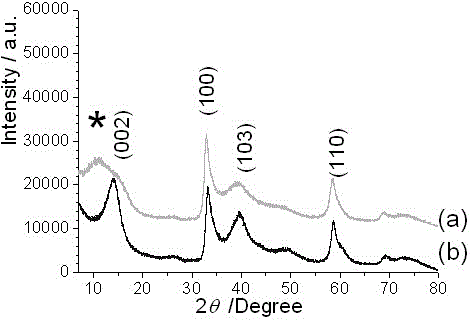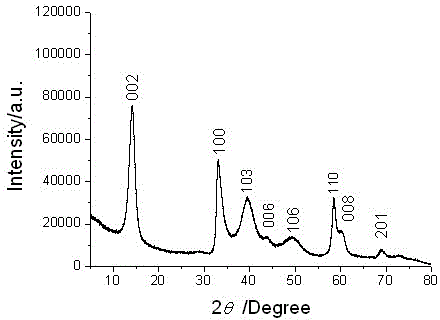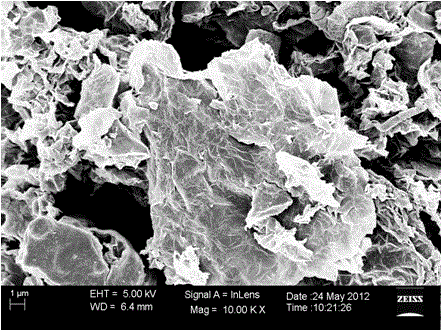Preparation method of graphene-like MoS2/graphene combined electrode of lithium ion battery
A graphene composite and lithium-ion battery technology, which is applied to battery electrodes, circuits, electrical components, etc., can solve the problems of long time consumption and large organic solvent consumption, and achieve the effect of simple process and high specific capacity of electrochemical lithium storage
- Summary
- Abstract
- Description
- Claims
- Application Information
AI Technical Summary
Problems solved by technology
Method used
Image
Examples
Embodiment 1
[0030] 1) Ultrasonic disperse 2.5 mmol graphene oxide in 60 mL deionized water, then add 1.6 mmol cetyltrimethylammonium bromide cationic surfactant, and stir thoroughly;
[0031] 2) Then add 0.75g (6.19 mmol) L-cysteine and 0.3g (1.24 mmol) sodium molybdate (Na 2 MoO 4 2H 2 0), and constantly stir to make L-cysteine and sodium molybdate dissolve completely;
[0032] 3) Transfer the mixed liquid obtained in step (2) to a 100 mL hydrothermal reaction kettle, and add deionized water to adjust the volume to 80 mL, put the reaction kettle in a constant temperature oven, and conduct a hydrothermal reaction at 240 °C for 24 h Afterwards, let it cool down to room temperature naturally, collect the solid product by centrifugation, wash it thoroughly with deionized water, and dry it under vacuum at 100°C;
[0033] 4) The solid product obtained above was heat-treated at 800 °C for 2 h in a nitrogen / hydrogen mixed atmosphere, and the volume ratio of hydrogen in the mixed gas was 1...
Embodiment 2
[0045] 1) Ultrasonic disperse 2.5 mmol graphene oxide in 60 mL deionized water, then add 0.8 mmol cetyltrimethylammonium bromide cationic surfactant, and stir thoroughly;
[0046] 2) Then add 0.75g (6.19 mmol) L-cysteine and 0.3g (1.24 mmol) sodium molybdate (Na 2 MoO 4 2H 2 0), and constantly stir to make L-cysteine and sodium molybdate dissolve completely;
[0047] 3) Transfer the mixed liquid obtained in step (2) to a 100 mL hydrothermal reaction kettle, and add deionized water to adjust the volume to 80 mL, put the reaction kettle in a constant temperature oven, and conduct a hydrothermal reaction at 240 °C for 24 h Afterwards, let it cool down to room temperature naturally, collect the solid product by centrifugation, wash it thoroughly with deionized water, and dry it under vacuum at 100°C;
[0048] 4) The solid product obtained above was heat-treated at 800 °C for 2 h in a nitrogen / hydrogen mixed atmosphere, and the volume ratio of hydrogen in the mixed gas was 1...
Embodiment 3
[0055] 1) Ultrasonic disperse 2.5 mmol graphene oxide in 60 mL deionized water, then add 1.6 mmol dodecyltrimethylammonium bromide cationic surfactant, and stir thoroughly;
[0056] 2) Then add 0.75g (6.19 mmol) L-cysteine and 0.3g (1.24 mmol) sodium molybdate (Na 2 MoO 4 2H 2 0), and constantly stir to make L-cysteine and sodium molybdate dissolve completely;
[0057] 3) Transfer the mixed liquid obtained in step (2) to a 100 mL hydrothermal reaction kettle, and add deionized water to adjust the volume to 80 mL, put the reaction kettle in a constant temperature oven, and conduct a hydrothermal reaction at 250 °C for 24 h Afterwards, let it cool down to room temperature naturally, collect the solid product by centrifugation, wash it thoroughly with deionized water, and dry it under vacuum at 100°C;
[0058] 4) The solid product obtained above was heat-treated at 800 °C for 2 h in a nitrogen / hydrogen mixed atmosphere, and the volume ratio of hydrogen in the mixed gas was...
PUM
 Login to View More
Login to View More Abstract
Description
Claims
Application Information
 Login to View More
Login to View More - R&D
- Intellectual Property
- Life Sciences
- Materials
- Tech Scout
- Unparalleled Data Quality
- Higher Quality Content
- 60% Fewer Hallucinations
Browse by: Latest US Patents, China's latest patents, Technical Efficacy Thesaurus, Application Domain, Technology Topic, Popular Technical Reports.
© 2025 PatSnap. All rights reserved.Legal|Privacy policy|Modern Slavery Act Transparency Statement|Sitemap|About US| Contact US: help@patsnap.com



